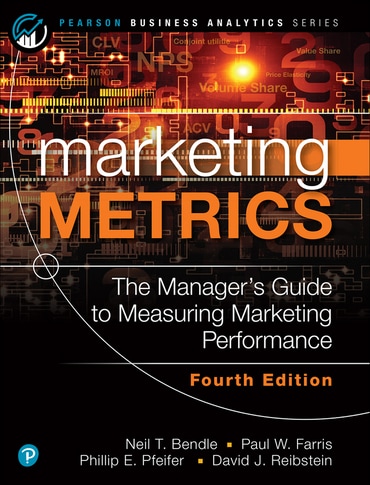Foreword xvii
Foreword to the Fourth Edition xix
Chapter 1: Introduction 1
1.1 What Is a Metric? 1
1.2 Why Do You Need Metrics? 1
1.3 Marketing Metrics: Opportunities, Performance, and Accountability 2
1.4 Choosing the Right Numbers 3
1.5 What Are We Measuring? 3
1.6 Value of Information 5
1.7 Mastering Metrics 7
1.8 Where Are the “Top Ten” Metrics? 7
1.9 What Is New in the Fourth Edition? 9
1.10 New Developments in the World of Marketing Metrics 10
Chapter 2: Share of Hearts, Minds, and Markets 19
Introduction 19
2.1 Market Share 24
2.2 Relative Market Share and Market Concentration 27
2.3 Brand Development Index and Category Development Index 31
2.4 Penetration 33
2.5 Share of Requirements 36
2.6 Usage Index 40
2.7 Awareness, Attitudes, and Usage (AAU): Metrics of the Hierarchy of Effects 44
2.8 Customer Satisfaction and Willingness to Recommend 49
2.9 Net Promoter 53
2.10 Willingness to Search 55
2.11 Neuroscience Measures 57
Chapter 3: Margins and Profits 67
Introduction 67
3.1 Margins 71
3.2 Prices and Channel Margins 77
3.3 Average Price per Unit and Price per Statistical Unit 87
3.4 Variable Costs and Fixed Costs 93
3.5 Marketing Spending—Total, Fixed, and Variable 99
3.6 Break-Even Analysis and Contribution Analysis 104
3.7 Profit-Based Sales Targets 108
Chapter 4: Product and Portfolio Management 113
Introduction 113
4.1 Trial, Repeat, Penetration, and Volume Projections 116
4.2 Growth: Percentage and CAGR 129
4.3 Cannibalization Rates and Fair Share Draw 134
4.4 Brand Equity Metrics 140
4.5 Conjoint Utilities and Consumer Preference 149
4.6 Segmentation Using Conjoint Utilities 154
4.7 Conjoint Utilities and Volume Projection 157
Chapter 5: Customer Profitability 159
Introduction 159
5.1 Customers, Recency, and Retention 162
5.2 Customer Profit 167
5.3 Customer Lifetime Value 172
5.4 Prospect Lifetime Value Versus Customer Value 178
5.5 Acquisition Versus Retention Cost 182
Chapter 6: Sales Force Management 185
Introduction 185
6.1 Sales Force Coverage: Territories 187
6.2 Sales Force Objectives: Setting Goals 190
6.3 Sales Force Effectiveness: Measuring Effort, Potential, and Results 194
6.4 Sales Force Compensation: Salary/Reward Mix 198
6.5 Sales Force Tracking: Pipeline Analysis 201
Chapter 7: Channel Management 207
Introduction 207
7.1 Numeric, ACV and PCV Distribution, Facings/Share of Shelf 210
7.2 Supply Chain Metrics 217
7.3 SKU Profitability: Markdowns, GMROII, and DPP 223
7.4 Online Distribution Metrics 228
7.5 Combining Search and Distribution 230
7.6 Understanding Channel Dependencies 231
Chapter 8: Pricing Strategy 235
Introduction 235
8.1 Price Premium 238
8.2 Reservation Price and Percent Good Value 242
8.3 Price Elasticity of Demand 248
8.4 Optimal Prices and Linear and Constant Demand Functions 255
8.5 Own, Cross, and Residual Price Elasticity 268
Chapter 9: Promotion 279
Introduction 279
9.1 Baseline Sales, Incremental Sales, and Promotional Lift 282
9.2 Redemption Rates, Costs for Coupons and Rebates, and Percentage Sales with Coupon 290
9.3 Promotions and Pass-Through 293
9.4 Price Waterfall 296
Chapter 10: Advertising and Sponsorship Metrics 303
Introduction 303
10.1 Advertising: Impressions, Exposures, Opportunities-to-See (OTS), Gross Rating Points (GRPs), and Target Rating Points (TRPs) 307
10.2 Cost per Thousand Impressions (CPM) Rates 312
10.3 Reach, Net Reach, and Frequency 314
10.4 Frequency Response Functions 318
10.5 Effective Reach and Effective Frequency 323
10.6 Share of Voice 325
10.7 Advertising Elasticity of Demand 327
10.8 Return on Advertising Spend (ROAS) 332
10.9 Equivalent Media Value from Sponsorship 334
10.10 Sponsorship ROI 336
Chapter 11: Online, Email, and Mobile Metrics 341
Introduction 341
11.1 Impressions and Pageviews 345
11.2 Media Display Time and Interaction Rate 348
11.3 Clickthrough Rates 351
11.4 Cost per Impression, Cost per Click, and Cost per Order 355
11.5 Visits, Visitors, and Abandonment 360
11.6 Bounce Rate (website) 364
11.7 Social Media Metrics: Friends/Followers/Supporters/Likes 367
11.8 Downloads 370
11.9 Mobile Metrics 372
11.10 Email Metrics 374
Chapter 12: Marketing and Finance 377
Introduction 377
12.1 Net Profit and Return on Sales 380
12.2 Return on Investment 382
12.3 Economic Profit—EVA 383
12.4 Evaluating Multi-period Investments 386
12.5 Marketing Return on Investment 390
12.6 Financial Market Measures 397
12.7 Combined Market and Accounting Measures 399
Chapter 13: The Marketing Metrics X-Ray and Testing 403
13.1 The Marketing Metrics X-Ray 403
13.2 The Value of Information 412
13.3 Testing 414
Chapter 14: System of Metrics 421
14.1 Modeling Firm Performance 421
14.2 Three Reasons for Using Systems of Identities in Marketing 424
14.3 Marketing Mix Models: Monitoring Relationships Between Marketing Decisions and Objectives 429
14.4 Related Metrics and Concepts 433
Bibliography 435
Endnotes 439
Index 447


